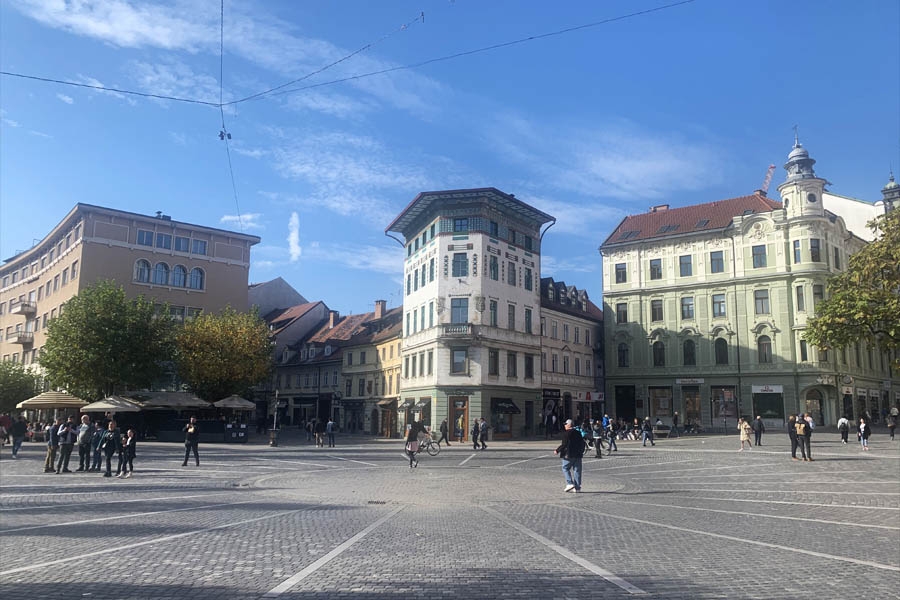The city centre is “car-free”. Ljubljana has restricted access to private vehicles and promoted pedestrian zones. It helps to reduce air pollution and raise the overall quality of the urban environment, says Klemen Gostic, representative of Regional Development Agency of the Ljubljana urban region (RRA LUR) for Demostat.

The city centre is “car-free”. Ljubljana has restricted access to private vehicles and promoted pedestrian zones. It helps to reduce air pollution and raise the overall quality of the urban environment, says Klemen Gostic, representative of Regional Development Agency of the Ljubljana urban region (RRA LUR) for Demostat.

The city has indeed taken various steps to tackle environmental challenges and pollution. Although improvements are still needed, we can freely say that we are successfully dealing with most of the problems by applying appropriate measures, says Klemen Gostic, Cohesion Policy Advisor to the Director of the Regional Development Agency of the Ljubljana Urban Region (RRA LUR), answering the question how does Ljubljana, which was declared a "European Green capital" in 2016, struggle with problems caused by pollution.
Our interlocutor points out that the city centre is “car-free”. As he explains, Ljubljana has “restricted access to private vehicles and promoted pedestrian zones”.
- It helps to reduce air pollution and overall quality of the urban environment. The results can be seen most along Slovenska Street. Then, the improvement of public transport. By investing and improving public transport infrastructure, we have encouraged citizens to use cars, bicycles and other sustainable modes of transport. A multi-purpose (unified) map called “URBANA” has greatly improved this use, and the “fleet” of green buses is slowly expanding, Gostic said.
The interlocutor of Demostat from Ljubljana also notes that initiatives have been launched that are in the favour of cyclists.
- We are developing bicycle paths and infrastructure to promote cycling as a sustainable and healthy mode of transport. There are currently about 300 kilometers of cycling infrastructure, in various forms, in Ljubljana. The bicycle sharing Program (”BicikeLJ“) experienced success and helped promote the “culture of cycling”.
Gostic also cites the importance of investments in green spaces and urban planning. As he specifies, “Ljubljana is very interested in investing in urban planning that prioritises green spaces, parks and sustainable architecture”.
Demostats interlocutor also points to the importance of “raising awareness and educating” citizens about environmental protection, “not only during European Mobility Week, but also in general, a number of awareness campaigns and educational programs are being implemented, in order to inform citizens about the importance of sustainable practices and pollution reduction”.
- The city of Ljubljana is doing a lot to involve schools, different social groups and businesses in environmental initiatives to promote pollution reduction, in a broader sense - reducing pollution caused by waste, as well as reducing the use of cars. Also, Ljubljanas heating systems do not use old wood stoves, which were a major source of pollution in previous decades and the city has invested a lot in cooperation with international organizations, other cities that have been declared “European Green capitals”, and interested actors, in order to exchange best practices and ideas for sustainable urban development, he emphasizes.
Asked what are the most important elements of the “local energy concept and Waste Management” in the Slovenian capital, Gostic said that Ljubljana is largely focused on energy efficiency measures, which implies “the application of energy-efficient technologies and practices on public buildings, flat lighting and infrastructure”. He also pointed out that Ljubljana signed the SECAP document.

Klemen Gosti?/Photo: RRA LUR
The local government is also trying to promote energy efficient devices and practices among citizens and businesses (recently, small “grids” are very popular and improved - solar energy). When it comes to waste management, the main project is the Ljubljana Regional Waste Management Centre (RCERO Ljubljana), which is the largest environmental project in Slovenia, and is supported by the Cohesion Fund, and includes the largest modern waste treatment facility in Europe - where waste is processed for a third of Slovenia. Also, the Regional Development Agency of the Ljubljana Urban Region is part of the SECAP project, within which the SECAP document was signed, which is focused on energy saving in municipal buildings, explains Gostic.
Answering the question of whether he can give any piece of advice to Belgrade when it comes to the organization of bicycle routes, since such a form of transport is very functional in Ljubljana, our interlocutor points out that “the main solution, which made this form of transport so efficient, is the system of so-called concessions, where the municipality hired a private operator for bicycle rental and maintenance services”.
- The same operator, who strives to run the system as best as possible, is also in charge of billboards in the public area. The "BicikeLj" system is widespread in Ljubljana, and now 80 stations and 880 bicycles are available to people. The biggest “trigger” for good use is the ease of use of services (APP or urban map), while operators are allowed to save bicycle user data as confidential, thus preventing vandalism, he says.
Asked to comment on how the system in Ljubljana calls “integrated public transport between urban and rural areas” works, Gosti? said that the best examples of such services serving “connections in the wider Ljubljana area” include “extending public transport networks or urban lines to a wider area”. In this context, he points out that “the scope of the urban transport system has been expanded, in order to connect suburban and rural areas, and that new routes for buses and trains have been established, including the surrounding regions (regional routes) - direct lines, with only two stops”.
Also, our interlocutor mentions the systems of "smart cards“, which are known as”URBANA".
-The implementation of the “smart card” system has enabled customers to use a single ticket for different modes of transport (urban and rural buses), and the urban ticket can also be used for parking and driving services.
Gostic also notes that there are 13 parking and driving stations (P plus R), from which the center of Ljubljana can be reached using public transport, the system “BicikeLj” or NOMAGO, and that there is organized transport to work in the center of Ljubljana of employees (SmartMOVE), who live in Kranj, Kamnik, Domžala, Radomlje, Trzin and Mengeš.
Asked to clarify the concept of “regional mobile centers”, which the city authorities of Ljubljana often mention when they talk about plans for the near future, Klemen Gostic says that this is a practice that will be implemented within the framework of the “transnational project called ReMOBIL”.
-The main goal of ReMOBIL, which will be achieved through the establishment of regional mobile centres (RMC), is to create plans for effective sustainability in the regions, through the application of good practices from abroad. Our RMC LUR will consist of two or three employees, who will be in charge of communicating with leading regional actors, in order to improve sustainable mobility and spatial planning, in order to better connect. We are currently in the process of preparing a methodology, establishing a model of administration, which will provide the basic foundations for the establishment and operation of regional mobile centers. Guidelines will be provided for broader systemic governance models at the regional level. The work of regional mobile centers will also enable better cooperation between regional and national levels in charge of Transport (Ministry of infrastructure – directorate for sustainable mobility and transport policy), as well as those responsible for Spatial Planning (Ministry of Environment), and digitalization of the Ministry of Public Administration. It is envisaged that in the long run, the RMC model and its employees will be financed from the national level.
City authorities in Ljuljana often emphasize that "central services are well developed". As Klemen Gostic explains: “Ljubljana, the capital of Slovenia, has taken significant steps in various development functions, and holds the position of a progressive European Capital, and the main activities related to “Central Services” include: active sustainable urban development (Ljubljana made sustainability a priority, which is why it was awarded the title of European Green Capital in year 2016. The city is focused on environmental initiatives, promoting green spaces and investing in efficient public transport”).
Also, our interlocutor states that Ljubljana is a "cultural center".
- Ljubljana is proud of its rich cultural scene. This city hosts numerous festivals, art exhibitions and events throughout the year. The preservation of historic sites, along with the existence of modern cultural spaces, creates a dynamic and inclusive environment, he said. He adds that the emphasis is also on " innovation and technology”, as well as “tourism and the service sector”.
- This city encourages innovation and Technology, seeking to become a hub for start-ups and creative industries. Initiatives such as the Ljubljana Technology Park and R & D support contribute to the “flourishing of the technological ecosystem”. Ljubljana has also become a popular tourist destination, attracting visitors with its picturesque architecture, diverse culinary scene and hospitable atmosphere. The tourism sector has become a key driver of economic development and international recognition. Thanks to the efforts made in developing infrastructure and services (Slovenian government offices, universities and hospitals), Ljubljana remains a well-connected and central city. The modernization of transport networks, including the expansion of bicycle paths, improves accessibility and supports sustainable travel from home to work and back, he concludes.
In all societies there are issues that are rather being skipped. Certain...
The neoliberal path, started in 2001, has led to especially bad results in Serbi...
For centuries, the region was subsumed within the Ottoman and Hungarian Empires,...
"Serbia has returned to the systemic and anti-systemic position of the political...
In reality, Serbia is closer than ever to NATO. In the course of the last five y...